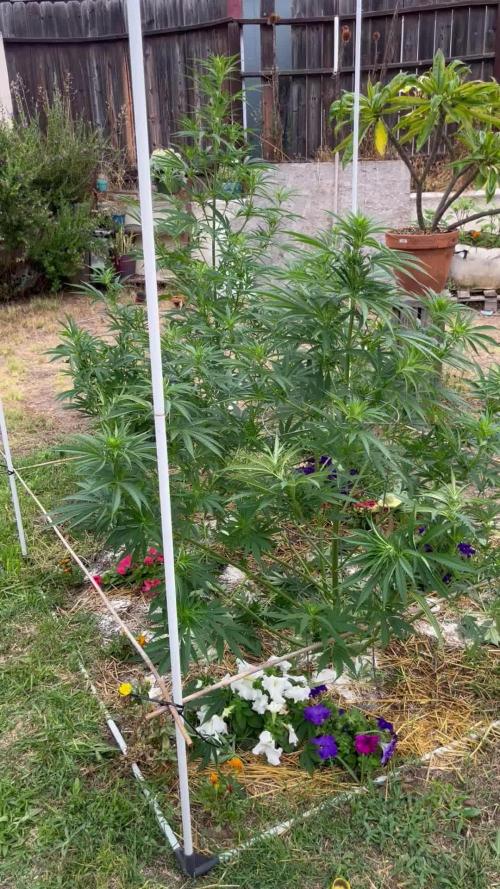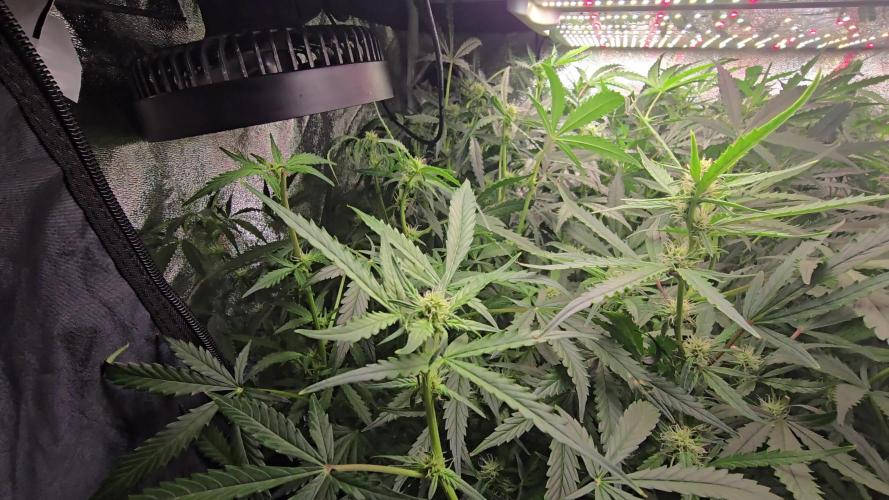The Grow Awards 2026 🏆 





























Likes
14
Share


@FeverForest
Follow
Light is now at 100% intensity, and I have begun adding RAW BLOOM Microbes to the soil.
Going to let it go another week before I defoliate again.
Likes
9
Share


@eldruida_lamota
Follow
Venga familia, que actualizo la 8 semana de floración de estas Kritical.
Ya se ven en la recta final , falta madurar un poco más, yo creo que con 10,14 días estarían ya apañadas pero decir es aproximar.
Ya se realizó el lavado de raíces, y aparte llevan una semana ya solo con agua.
La verdad que hasta aquí estoy contento con el resultado hasta ahora.
Agrobeta:
https://www.agrobeta.com/agrobetatiendaonline/36-abonos-canamo
Mars hydro:
Code discount: EL420
https://www.mars-hydro.com/
Las maximas de temperatura no superan los 26 grados y las mínimas no bajan 20, así que no me puedo quejar.
Los niveles de humedad también son los correctos van entre 45%/55% de humedad relativa.
Por supuesto el Ph lo estamos dejando alrededor de 6.
Hasta aquí es todo, buenos humos 💨💨💨.
Likes
3
Share


@Jaschkoo0
Follow
On Day 29 i gave her 1l of water with some supervite and 3.5 ml of bloom complex. I later added 500ml with 0.5ml of calmag 1ml powerzyme some alg a mic melasse and supervite.
On Day 26 i gave her 1.5l of water with 10ml of root coomplex 4ml of powerzyme and some supervite as well as an ph of 6.5
On Day 29 i gave her 1l with 3ml of bloom complex 1ml of calmag 1ml powerzyme and 5ml of rootjuice.
On Day 30 i placed her outside
On Day 32 i gave her 1l of water with 2ml of powerzyme and 1ml of calmag.
On Day 34 i gave her 1.5 l wirh 5ml bloom complex 2ml of powerzyme 1.5ml of calmag an some supervite.
Processing
Likes
4
Share


@XoticGROW666
Follow
DAY 28 of Flowering🌸🌼
Frosting & Stackin up ❄️🌲
Insane ice cream terps 🍨🍦
Likes
5
Share


@alafmalaf
Follow
first day after a 12h night cycle, still have a big gnat problem. gonna go buy new bacteria, stickies and DT Earth. the grow shop just let me know that they got it back in stock but i haven't been able to find nematóides. doesn't seem to be a common practice here. i haven't watered them in a few days. the top soil is bone dry but the plants don't look like they're requesting water just yet so i think it's a good time to lay down the new dt earth and new yellow traps to see if we can kill the remainder. gonna grab some flowering ferts too while I'm at it.
Update:
got a bigger pot and some supergrow soil, only had time to transplant one of them today. but I decided to after them one more cycle before i do the DT earth.
update:
dt earth added, seems to be alright but not quite dry enough
Likes
49
Share


@MadeInGermany
Follow
Hi folks :-)
This week it has developed very nicely 👍 The shoots are starting to grow again, and will soon be ready to be tied down again 👍
I wish you all a nice weekend and let it grow 🍀🌱🙏🏻
Likes
2
Share


@Mastr
Follow
Hi today week 6 from seed and first week into flowering I switch light 11:30 light and 12:30 darkness to get best results
I done some defoliation from lower branches to plant get light and airflow
Guys I already see root in top off my soil and its 25L pot this grow amazing 😁😁
They already drunk 2L water every morning will update more photo and video soon
Likes
8
Share


@Northern_Ent
Follow
A slow start for this plant and it’s still pretty skinny but it looks like it will pull through.
Likes
Comments
Share


@AboGrows
Follow
started seeing pustils coming out. i consider this week one of flower. really early flower im having a feeling this will be a longggg flowering plant. did a heavy defoliation. first vid is before and second vid is after. i DONT want mold this year.
Likes
2
Share


@Ninjabuds
Follow
The Bubble OG plants are looking awesome! My tallest one is stacking up with super dense buds. It's crazy to think that the other one is almost ready to chop – the colors are so vibrant. And then there's that short and squat one with the purple leaves. It's definitely the oddball of the bunch, but I kind of like it.
The past few weeks have been so beautiful, watching the plants grow and change. It's amazing how something so small and fragile can turn into something so strong and vibrant. Now that they're getting ready to bloom, it feels a little bittersweet. I'm so excited to see the finished product, but I'll definitely miss having them around while they're growing.
Likes
51
Share


@Hempface86
Follow
WEEDSEEDSEXPRESS has awesome genetics... This girl is taking a beating and she's handling it well.. hope everyone is doing well and happy growing ✌️
Likes
2
Share


@Grandillustrator
Follow
Starting to look really nice had to take it out the tent as I hate the yellow tinge from the bulb cannot see the correct colour of leaves or how frosty she looks leaves look a little dark gonna start flush next watering , giving just over 2l every seccond day if I was to do this again I’d use a bigger pot but I was expecting this to be an auto. Branch with fasciation split into 4 still gonna get some nice buds on it just not as much as I could of had I noticed earlier in the grow
Likes
8
Share


@FarmerT
Follow
Cherry cola still has about 2 weeks left. But the other 3 are coming down this Thursday! I feel like this grow went very well for being a first timer !
Likes
34
Share


@Le_Duc_Du_Bud
Follow
Salut amis cultivateurs ✌️✂️🌿
Aujourd'hui je pose la nouvelle semaine 🗓️
Comment vous dire que je suis impressionnée ❗
Les plante ce développement a merveille voyait par vous même 🙏
Elles ont fortement grandi, je suis monter a 1.5L par plante, elle consomme la totalité des nutriments et me le montre très très bien 😍🤗
Merci Kannabia 🙏 encore des variétés merveilleuses 😊
J'espère que dame nature sera me récompense 🌿🍁
Pour plus d'informations par rapport à ces génétique, je vous laisse cliquer ici :
https://www.kannabia.com/fr
Processing
Likes
6
Share


@PoshGrow
Follow
Welcome to Auto Alaskan Purple Grow by PoshGrow!
🍀 Week #6 2020 August 27th - September 3th.
General Info:
When planted: 2020 July 23th.
Week: 6
Days: 35 - 42
Last Update Day: 2020 September 3th.
Plants: 5 Alaskan Purple Auto.
Equipment:
Tent: MarsHydro 1mx1mx2m or 39"x39"x72".
Light: HLG 260w V2 Rspec QB Kit.
Exhaust: 4" 322 CFM fan + Viper Carbon Filter.
Intake: 4" 100 CFM Inline Fan.
Oscillating Fan:
Lower: 4" Ram Fan.
Upper: 9" Voxon Box Fan.
Humidifier: Taotronics TT-AH001.
Dehumidifier: Pavlit MD750.
Soil: NPK soil 40% Compost, 50% Peat Moss, 10% Agroperlite.
Pot: 7 gallon Fabric Pot x 5pcs.
Nutriens: Fox Farm Trio.
PH Correcton: Chemoform pH-Minus Granulat.
PH Pen: Cheap Chinese one, I callibrate it every time I use it.
Water pump:
Digital microscope: cheap Chinese USB X4, 1600X.
Comment


























